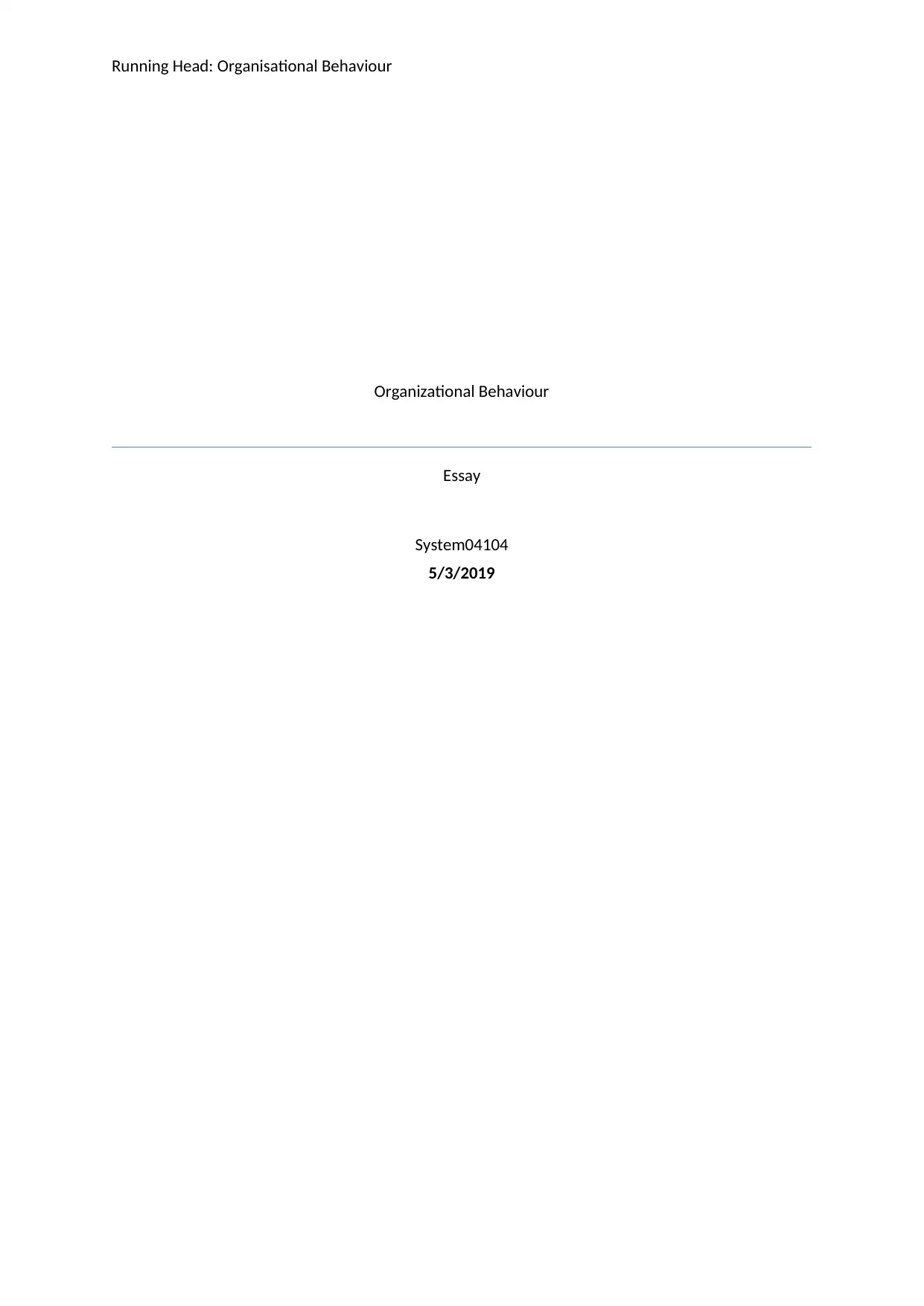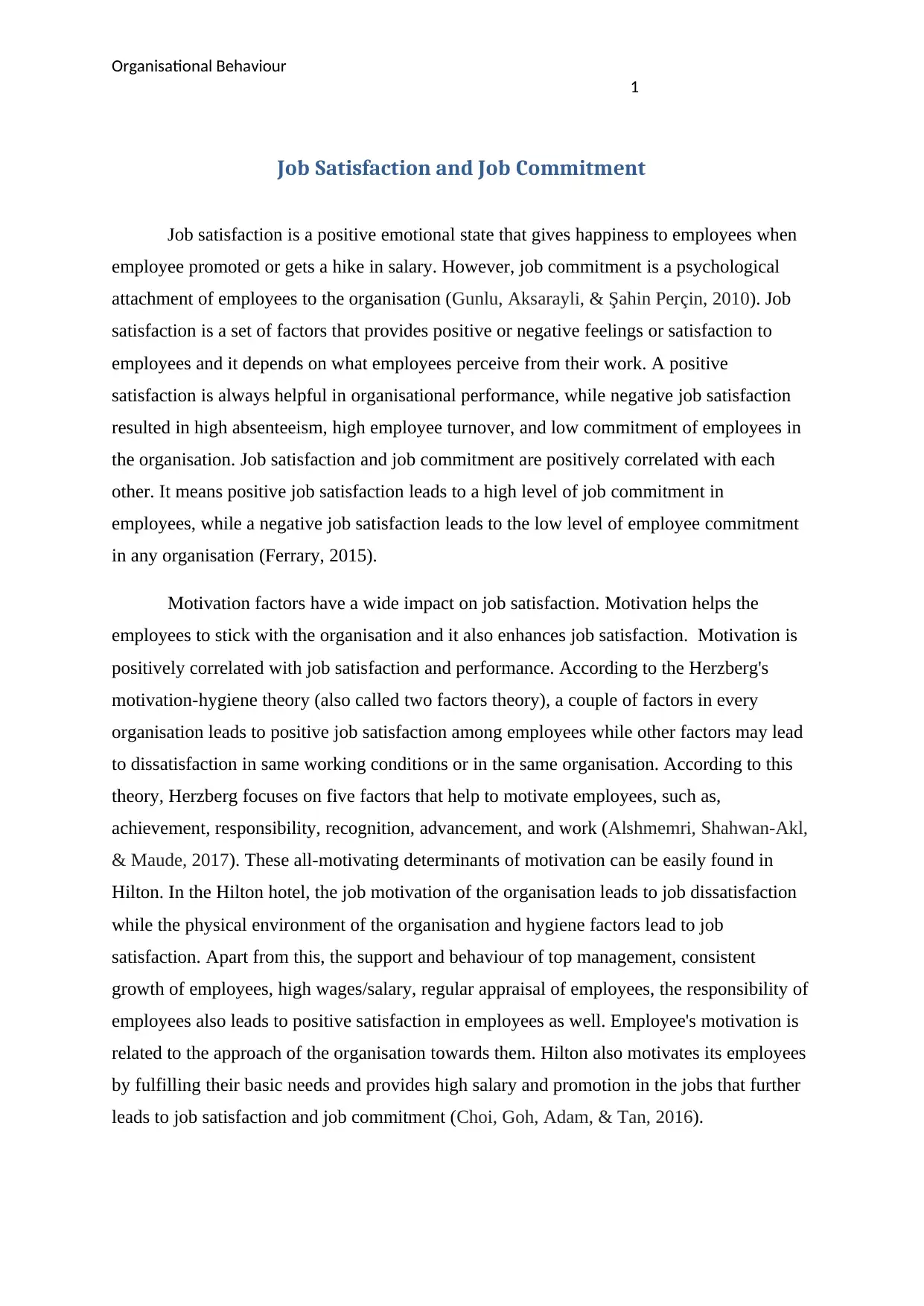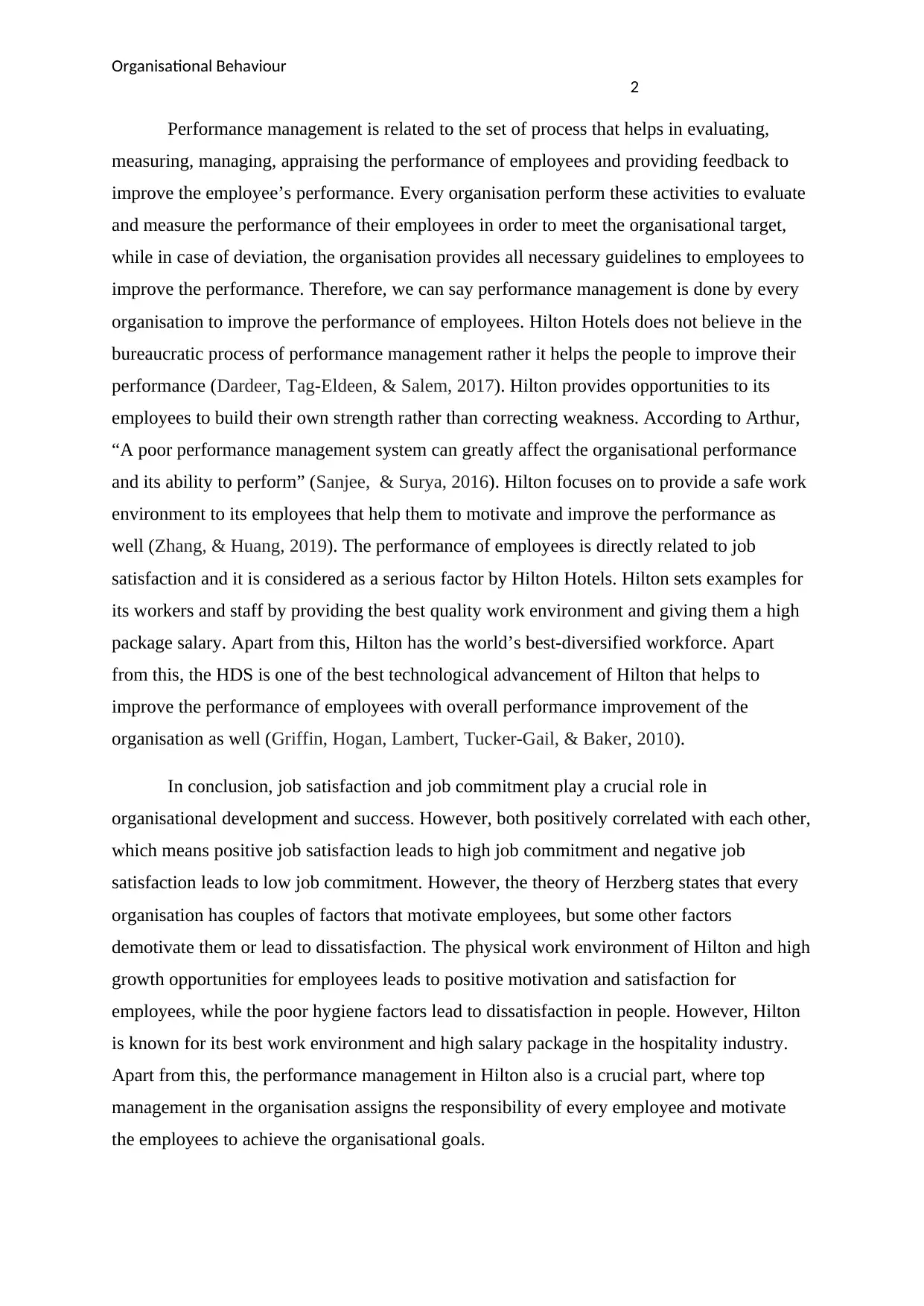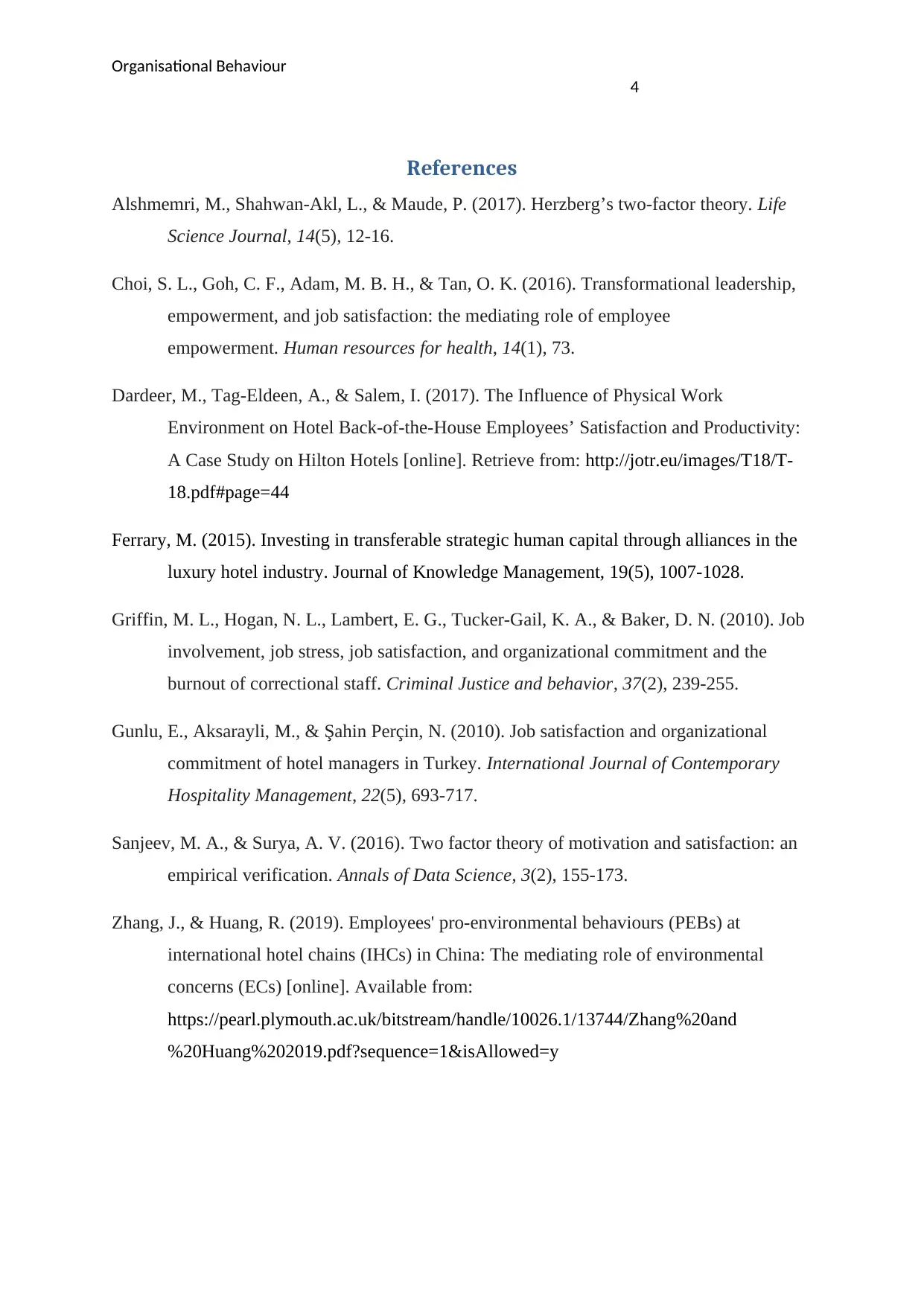Organisational Behaviour Essay: Performance and Employee Motivation
VerifiedAdded on 2023/01/06
|5
|1283
|22
Essay
AI Summary
This essay delves into the concepts of organisational behaviour, specifically focusing on job satisfaction, job commitment, and performance management. It explores the positive correlation between job satisfaction and commitment, highlighting how motivation, as per Herzberg's two-factor theory, impacts employee attitudes. The essay uses Hilton Hotels as a case study, examining how the company's work environment, employee growth opportunities, and performance management practices influence employee motivation and satisfaction. It concludes by emphasizing the crucial role these factors play in organisational success and development. The essay also references various academic sources to support its arguments.

Running Head: Organisational Behaviour
Organizational Behaviour
Essay
System04104
5/3/2019
Organizational Behaviour
Essay
System04104
5/3/2019
Paraphrase This Document
Need a fresh take? Get an instant paraphrase of this document with our AI Paraphraser

Organisational Behaviour
1
Job Satisfaction and Job Commitment
Job satisfaction is a positive emotional state that gives happiness to employees when
employee promoted or gets a hike in salary. However, job commitment is a psychological
attachment of employees to the organisation (Gunlu, Aksarayli, & Şahin Perçin, 2010). Job
satisfaction is a set of factors that provides positive or negative feelings or satisfaction to
employees and it depends on what employees perceive from their work. A positive
satisfaction is always helpful in organisational performance, while negative job satisfaction
resulted in high absenteeism, high employee turnover, and low commitment of employees in
the organisation. Job satisfaction and job commitment are positively correlated with each
other. It means positive job satisfaction leads to a high level of job commitment in
employees, while a negative job satisfaction leads to the low level of employee commitment
in any organisation (Ferrary, 2015).
Motivation factors have a wide impact on job satisfaction. Motivation helps the
employees to stick with the organisation and it also enhances job satisfaction. Motivation is
positively correlated with job satisfaction and performance. According to the Herzberg's
motivation-hygiene theory (also called two factors theory), a couple of factors in every
organisation leads to positive job satisfaction among employees while other factors may lead
to dissatisfaction in same working conditions or in the same organisation. According to this
theory, Herzberg focuses on five factors that help to motivate employees, such as,
achievement, responsibility, recognition, advancement, and work (Alshmemri, Shahwan-Akl,
& Maude, 2017). These all-motivating determinants of motivation can be easily found in
Hilton. In the Hilton hotel, the job motivation of the organisation leads to job dissatisfaction
while the physical environment of the organisation and hygiene factors lead to job
satisfaction. Apart from this, the support and behaviour of top management, consistent
growth of employees, high wages/salary, regular appraisal of employees, the responsibility of
employees also leads to positive satisfaction in employees as well. Employee's motivation is
related to the approach of the organisation towards them. Hilton also motivates its employees
by fulfilling their basic needs and provides high salary and promotion in the jobs that further
leads to job satisfaction and job commitment (Choi, Goh, Adam, & Tan, 2016).
1
Job Satisfaction and Job Commitment
Job satisfaction is a positive emotional state that gives happiness to employees when
employee promoted or gets a hike in salary. However, job commitment is a psychological
attachment of employees to the organisation (Gunlu, Aksarayli, & Şahin Perçin, 2010). Job
satisfaction is a set of factors that provides positive or negative feelings or satisfaction to
employees and it depends on what employees perceive from their work. A positive
satisfaction is always helpful in organisational performance, while negative job satisfaction
resulted in high absenteeism, high employee turnover, and low commitment of employees in
the organisation. Job satisfaction and job commitment are positively correlated with each
other. It means positive job satisfaction leads to a high level of job commitment in
employees, while a negative job satisfaction leads to the low level of employee commitment
in any organisation (Ferrary, 2015).
Motivation factors have a wide impact on job satisfaction. Motivation helps the
employees to stick with the organisation and it also enhances job satisfaction. Motivation is
positively correlated with job satisfaction and performance. According to the Herzberg's
motivation-hygiene theory (also called two factors theory), a couple of factors in every
organisation leads to positive job satisfaction among employees while other factors may lead
to dissatisfaction in same working conditions or in the same organisation. According to this
theory, Herzberg focuses on five factors that help to motivate employees, such as,
achievement, responsibility, recognition, advancement, and work (Alshmemri, Shahwan-Akl,
& Maude, 2017). These all-motivating determinants of motivation can be easily found in
Hilton. In the Hilton hotel, the job motivation of the organisation leads to job dissatisfaction
while the physical environment of the organisation and hygiene factors lead to job
satisfaction. Apart from this, the support and behaviour of top management, consistent
growth of employees, high wages/salary, regular appraisal of employees, the responsibility of
employees also leads to positive satisfaction in employees as well. Employee's motivation is
related to the approach of the organisation towards them. Hilton also motivates its employees
by fulfilling their basic needs and provides high salary and promotion in the jobs that further
leads to job satisfaction and job commitment (Choi, Goh, Adam, & Tan, 2016).

Organisational Behaviour
2
Performance management is related to the set of process that helps in evaluating,
measuring, managing, appraising the performance of employees and providing feedback to
improve the employee’s performance. Every organisation perform these activities to evaluate
and measure the performance of their employees in order to meet the organisational target,
while in case of deviation, the organisation provides all necessary guidelines to employees to
improve the performance. Therefore, we can say performance management is done by every
organisation to improve the performance of employees. Hilton Hotels does not believe in the
bureaucratic process of performance management rather it helps the people to improve their
performance (Dardeer, Tag-Eldeen, & Salem, 2017). Hilton provides opportunities to its
employees to build their own strength rather than correcting weakness. According to Arthur,
“A poor performance management system can greatly affect the organisational performance
and its ability to perform” (Sanjee, & Surya, 2016). Hilton focuses on to provide a safe work
environment to its employees that help them to motivate and improve the performance as
well (Zhang, & Huang, 2019). The performance of employees is directly related to job
satisfaction and it is considered as a serious factor by Hilton Hotels. Hilton sets examples for
its workers and staff by providing the best quality work environment and giving them a high
package salary. Apart from this, Hilton has the world’s best-diversified workforce. Apart
from this, the HDS is one of the best technological advancement of Hilton that helps to
improve the performance of employees with overall performance improvement of the
organisation as well (Griffin, Hogan, Lambert, Tucker-Gail, & Baker, 2010).
In conclusion, job satisfaction and job commitment play a crucial role in
organisational development and success. However, both positively correlated with each other,
which means positive job satisfaction leads to high job commitment and negative job
satisfaction leads to low job commitment. However, the theory of Herzberg states that every
organisation has couples of factors that motivate employees, but some other factors
demotivate them or lead to dissatisfaction. The physical work environment of Hilton and high
growth opportunities for employees leads to positive motivation and satisfaction for
employees, while the poor hygiene factors lead to dissatisfaction in people. However, Hilton
is known for its best work environment and high salary package in the hospitality industry.
Apart from this, the performance management in Hilton also is a crucial part, where top
management in the organisation assigns the responsibility of every employee and motivate
the employees to achieve the organisational goals.
2
Performance management is related to the set of process that helps in evaluating,
measuring, managing, appraising the performance of employees and providing feedback to
improve the employee’s performance. Every organisation perform these activities to evaluate
and measure the performance of their employees in order to meet the organisational target,
while in case of deviation, the organisation provides all necessary guidelines to employees to
improve the performance. Therefore, we can say performance management is done by every
organisation to improve the performance of employees. Hilton Hotels does not believe in the
bureaucratic process of performance management rather it helps the people to improve their
performance (Dardeer, Tag-Eldeen, & Salem, 2017). Hilton provides opportunities to its
employees to build their own strength rather than correcting weakness. According to Arthur,
“A poor performance management system can greatly affect the organisational performance
and its ability to perform” (Sanjee, & Surya, 2016). Hilton focuses on to provide a safe work
environment to its employees that help them to motivate and improve the performance as
well (Zhang, & Huang, 2019). The performance of employees is directly related to job
satisfaction and it is considered as a serious factor by Hilton Hotels. Hilton sets examples for
its workers and staff by providing the best quality work environment and giving them a high
package salary. Apart from this, Hilton has the world’s best-diversified workforce. Apart
from this, the HDS is one of the best technological advancement of Hilton that helps to
improve the performance of employees with overall performance improvement of the
organisation as well (Griffin, Hogan, Lambert, Tucker-Gail, & Baker, 2010).
In conclusion, job satisfaction and job commitment play a crucial role in
organisational development and success. However, both positively correlated with each other,
which means positive job satisfaction leads to high job commitment and negative job
satisfaction leads to low job commitment. However, the theory of Herzberg states that every
organisation has couples of factors that motivate employees, but some other factors
demotivate them or lead to dissatisfaction. The physical work environment of Hilton and high
growth opportunities for employees leads to positive motivation and satisfaction for
employees, while the poor hygiene factors lead to dissatisfaction in people. However, Hilton
is known for its best work environment and high salary package in the hospitality industry.
Apart from this, the performance management in Hilton also is a crucial part, where top
management in the organisation assigns the responsibility of every employee and motivate
the employees to achieve the organisational goals.
⊘ This is a preview!⊘
Do you want full access?
Subscribe today to unlock all pages.

Trusted by 1+ million students worldwide

Organisational Behaviour
3
3
Paraphrase This Document
Need a fresh take? Get an instant paraphrase of this document with our AI Paraphraser

Organisational Behaviour
4
References
Alshmemri, M., Shahwan-Akl, L., & Maude, P. (2017). Herzberg’s two-factor theory. Life
Science Journal, 14(5), 12-16.
Choi, S. L., Goh, C. F., Adam, M. B. H., & Tan, O. K. (2016). Transformational leadership,
empowerment, and job satisfaction: the mediating role of employee
empowerment. Human resources for health, 14(1), 73.
Dardeer, M., Tag-Eldeen, A., & Salem, I. (2017). The Influence of Physical Work
Environment on Hotel Back-of-the-House Employees’ Satisfaction and Productivity:
A Case Study on Hilton Hotels [online]. Retrieve from: http://jotr.eu/images/T18/T-
18.pdf#page=44
Ferrary, M. (2015). Investing in transferable strategic human capital through alliances in the
luxury hotel industry. Journal of Knowledge Management, 19(5), 1007-1028.
Griffin, M. L., Hogan, N. L., Lambert, E. G., Tucker-Gail, K. A., & Baker, D. N. (2010). Job
involvement, job stress, job satisfaction, and organizational commitment and the
burnout of correctional staff. Criminal Justice and behavior, 37(2), 239-255.
Gunlu, E., Aksarayli, M., & Şahin Perçin, N. (2010). Job satisfaction and organizational
commitment of hotel managers in Turkey. International Journal of Contemporary
Hospitality Management, 22(5), 693-717.
Sanjeev, M. A., & Surya, A. V. (2016). Two factor theory of motivation and satisfaction: an
empirical verification. Annals of Data Science, 3(2), 155-173.
Zhang, J., & Huang, R. (2019). Employees' pro-environmental behaviours (PEBs) at
international hotel chains (IHCs) in China: The mediating role of environmental
concerns (ECs) [online]. Available from:
https://pearl.plymouth.ac.uk/bitstream/handle/10026.1/13744/Zhang%20and
%20Huang%202019.pdf?sequence=1&isAllowed=y
4
References
Alshmemri, M., Shahwan-Akl, L., & Maude, P. (2017). Herzberg’s two-factor theory. Life
Science Journal, 14(5), 12-16.
Choi, S. L., Goh, C. F., Adam, M. B. H., & Tan, O. K. (2016). Transformational leadership,
empowerment, and job satisfaction: the mediating role of employee
empowerment. Human resources for health, 14(1), 73.
Dardeer, M., Tag-Eldeen, A., & Salem, I. (2017). The Influence of Physical Work
Environment on Hotel Back-of-the-House Employees’ Satisfaction and Productivity:
A Case Study on Hilton Hotels [online]. Retrieve from: http://jotr.eu/images/T18/T-
18.pdf#page=44
Ferrary, M. (2015). Investing in transferable strategic human capital through alliances in the
luxury hotel industry. Journal of Knowledge Management, 19(5), 1007-1028.
Griffin, M. L., Hogan, N. L., Lambert, E. G., Tucker-Gail, K. A., & Baker, D. N. (2010). Job
involvement, job stress, job satisfaction, and organizational commitment and the
burnout of correctional staff. Criminal Justice and behavior, 37(2), 239-255.
Gunlu, E., Aksarayli, M., & Şahin Perçin, N. (2010). Job satisfaction and organizational
commitment of hotel managers in Turkey. International Journal of Contemporary
Hospitality Management, 22(5), 693-717.
Sanjeev, M. A., & Surya, A. V. (2016). Two factor theory of motivation and satisfaction: an
empirical verification. Annals of Data Science, 3(2), 155-173.
Zhang, J., & Huang, R. (2019). Employees' pro-environmental behaviours (PEBs) at
international hotel chains (IHCs) in China: The mediating role of environmental
concerns (ECs) [online]. Available from:
https://pearl.plymouth.ac.uk/bitstream/handle/10026.1/13744/Zhang%20and
%20Huang%202019.pdf?sequence=1&isAllowed=y
1 out of 5
Related Documents
Your All-in-One AI-Powered Toolkit for Academic Success.
+13062052269
info@desklib.com
Available 24*7 on WhatsApp / Email
![[object Object]](/_next/static/media/star-bottom.7253800d.svg)
Unlock your academic potential
Copyright © 2020–2025 A2Z Services. All Rights Reserved. Developed and managed by ZUCOL.



